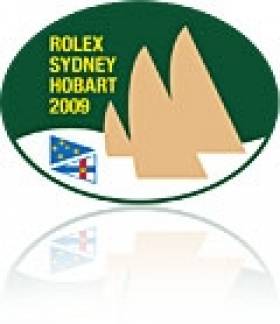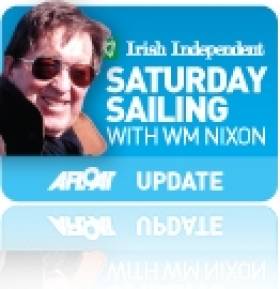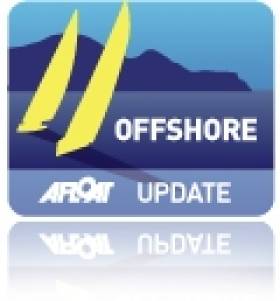Displaying items by tag: Gordon Maguire
Ireland Hit The High Spot In The Sydney Hobart Race 23 Years Ago
#rshyr – Ireland's fascination with the Rolex Sydney-Hobart Race moved onto a new plane in 1991, when a three-boat Irish team team of all the talents had a runaway win in the Southern Cross Series which culminated with the 628-mile race to Hobart. The three skipper/helmsmen who led the squad to this famous victory twenty-three years ago were Harold Cudmore, Joe English and Gordon Maguire, all on top of their game.
These days, the incomparable Harold Cudmore is still a sailing legend, though mostly renowned now for his exceptional ability to get maximum performance out of large classics such as the 19 Metre Mariquita, sailing mainly in European waters.
But sadly, Joe English passed away just eight weeks ago in November in Cork, much mourned by many friends worldwide. Yet for Gordon Maguire, the experience of sailing at the top level in Australia was life-changing. He took to Australia in a big way, and Australia took to him as he built a professional sailing career. And he's still at it in the offshore racing game as keenly as ever, with 19 Sydney-Hobarts now logged, including two overall wins.
He raced the challenging course of this 70th 2014 edition as sailing master of the Carkeek 60 Ichi Ban, a boat which is still only 15 months old, having made a promising though not stellar debut in 2013's race. Also making a determined challenge was the First 40 Breakthrough with a strong Irish element in the crew led by Barry Hurley, fresh from the class win and second overall in October's Rolex Midde Sea Race.
And high profile Irish interest was also to be found aboard the Botin 65 Caro, the record breaker in the 2013 ARC Transatlantic Race. She's a very advanced German-built "racer/cruiser" aboard which Ian Moore - originally of Carrickfergus but longtime Solent-side resident - was sailing as navigator.
W M Nixon casts an eye back over the 2014 race, whose prize-giving took place in Hobart yesterday, and then concludes by taking us back to 1991, when Ireland moved top of the league in the Offshore Racing World Team Championship on the same occasion some 23 years ago.
It has to have been the most keenly-anticipated debut in recent world sailing at the top level. At last we'd get to see how Comanche could go in serious sailing. When the 70th 628-mile Rolex Sydney-Hobart Race started on Friday December 26th at 0200 hours our time, 1300 hrs local time in Sydney Harbour, this was for real. There may have been 117 boats of all shapes and sizes from 33ft to 100ft in the fleet. But all eyes were on the limit-pushing 100ft Comanche, skippered by the great Kenny Read. The world wanted to see how she would show what she could do when the chips were down, when the racing was straight line stuff, and when some serious offshore battling was in prospect instead of the inshore-hopping mini-test which had been seen in the Solas Big Boat Challenge in Sydney Harbour on December 9th.
In that, the well-tested Wild Oats XI, skippered by Mark Richards, had sailed a canny race to take the line honours win from the other hundred footers. But the majestic Comanche, owned by Jim Clark and his Australian wife Kristy Hinze Clark, had shown enough bursts of speed potential to raise the temperature as the start of the big one itself approached.
And in a brisk southerly at the start, Comanche didn't disappoint. She just zapped away from Wild Oats to lead by a clear 30 seconds and notch a record time at the first turning mark to take the fleet out of Sydney Harbour, and that dream debut was what made the instant headlines on the beginning of the 628–mile slog to Hobart.
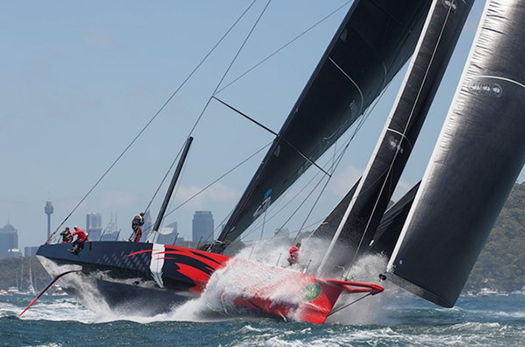
The moment of glory – the mighty Comanche roaring down Sydney Hobart at the start to log a record time to the first turning mark. Photo: Rolex/Daniel Forster
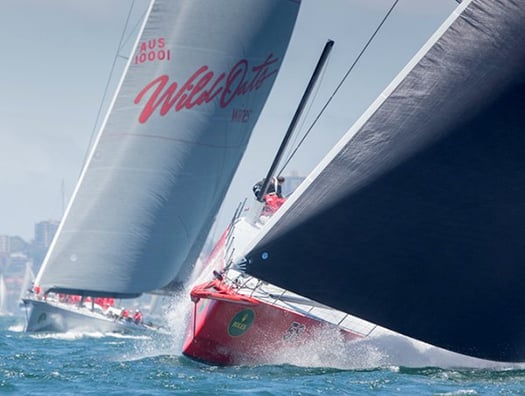
No two ways about it – Comanche is clear ahead of Wild Oats XI approaching the first mark. Photo: Rolex/Daniel Forster
But out at sea, with winds strengths varying but mostly from the south for the first day or so, different stories begin to emerge. A grand sunny southerly sailing breeze may provide lovely sailing and pure spectacle in Sydney Harbour. But get out into the Tasman Sea to head south for Hobart, and you find that the wayward south-going current – always a crucial factor in the early stages of the race to Hobart – can be going great guns and making mischief as a weather-going stream, kicking up a steep sea which can be boat-breaking when that last ounce of performance is being squeezed out.
And as previewed here on December 20th, up among the hundred-footers they've been pushing the envelope and then some in boat development and modification. In new boat terms, the mighty and notably beamy Comanche has gone about as far as they can go for now. But with the likes of the former Lahana reappearing as Rio 100 with a complete new rear half, and Syd Fischer's Ragamuffin 100 simply cutting away the hull for replacement with a complete new body unit while retaining the proven deck and rig, we're sailing right on the edge in terms of what the weird mixtures of new and old build can combine for combat when the seas are steep.
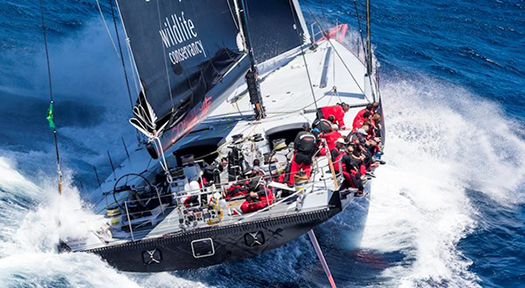
Comanche's wide beam gives added power when there's plenty of breeze......Photo: Rolex/Carlo Borlenghi
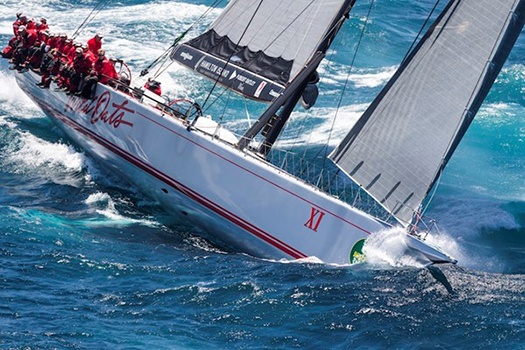
....but the narrow Wild Oats XI can be as slippery as an eel when the head seas get awkward, and when the wind eased she got through Comanche and into an extraordinary 40 mile lead on the water. Photo: Rolex/Carlo Borlenghi
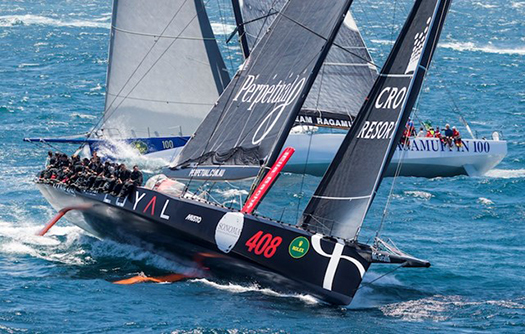
Not all boats revelled in the bone-shaking conditions of the first hundred miles of beating. Perpetual Loyal (foreground) had to pull out with hull damage possibly caused by an object in the water, but the irrepressible Syd Fischer's Ragamuffin 100 (beyond), with a completely new hull, continued going strong to the finish and was third in line honours Photo: Rolex/Carlo Borlenghi
But this glorious element of larger-than-life characters with boats that are off-the-wall is now an integral part of the RSHYR, which manages to attract an enormous amount of attention thanks to its placing in the midst of the dead of winter in the Northern Hemisphere, while in Australia much attention focuses on what is in effect an entire and familiar maritime community racing annually for the overall handicap prize.
Yet though the course is simple, it's deceptively so. Just because it's mainly a straight line from one harbour to another doesn't mean there aren't a zillion factors in play. And as the race gets so much attention, few offshore events of this length are so minutely analysed, and the first 24 hours provided a veritable laboratory for seeing the ways different boats behave in different wind and sea states with the breeze on the nose.
Thus Wild Oats XI has always had a formidable reputation for wiggling her exceptionally narrow hull to windward in awkward seas for all the world like a giant eel, and the early beating saw her doing that very thing, hanging in there neck and neck with Comanche. Despite her beamier hull, Comanche rates slightly lower than Wild Oats. But if a lull with its leftover sea arrived, her greater volume would become a liability to performance, whereas if the breeze got back to full strength, and particularly if it freed the two leaders, then Comanche would be firmly back in business.
But it was not be. Crossing the Bass Strait with Wild Oats right beside them, Comanche's crew saw their navigator Stan Honey emerge on deck and approach Kenny Read with a thoughtful expression on his face, and an ominous little slip of paper in his hand. It was the latest weather print-out, and it wasn't happy reading for a big wide boat that needs power in the breeze. Before expected brisk winds from the north set in, they'd to get through the lighter winds of an unexpectedly large and developing ridge.
Almost while they were still digesting this bit of bad news, Wild Oats started to cope much better with the lumpy leftover sea, and wriggled ahead of Comanche in her classic style. And the further she got ahead, the sooner she got into increasingly favourable wind pressure. As Read put it after the finish: "For twelve hours, conditions were perfect for Wild Oats, and they played a brilliant hand brilliantly".
Amazingly, the old Australian silver arrow opened out a clear lead of an incredible forty miles before conditions started to suit Comanche enough to start nibbling at this remarkable new margin. And fair play to the Read crew, at the finish they'd made such a comeback that Wild Oats was only something like 49 minutes ahead. But even with the new American boat's slightly lower rating, she was beaten on handicap too, and in the final rankings Wild Oats showed up as having line honours overall and a commendable 5th on IRC in Division 0 - and we shouldn't forget she won the overall handicap honours back in 2012 anyway.
But for 2014's race, for a while it looked as if it might be the Cookson 50s again for the overall win. But although last year's Tattersall's Cup winner, the Cookson 50 Victoire, at first took the Division 0 win with her sister-ship Pretty Fly III second, they were so close that when Pretty Fly got 13 minutes redress for an incident with the Ker 46 Patrice in mid-race, it reversed their placings.

It all came good in the end....after being initially placed second in Division 0, the ten-year-old Cookson 50 Pretty Fly III got 13 minutes of redress for an adverse incident during the race, and that bumped her up to the Division 0 win.
Either way, it was still Cookson 50s imprinted all over the sharp end of Division 0. But they were slipping in the overall rankings, where it was boats in the 40-45ft range which were settling into the best combination of timing and conditions to take the Tattersall's.
And plumb in the middle of them was the First 40 Breakthrough, with her strong Dublin Bay Sailing Club input from the Irish team led by Barry Hurley. Fortunes wax and wane with astonishing volatility as the Hobart race progresses, but gradually a pattern emerges. So though at one stage Breakthrough was showing up only around 30th overall, equally she'd a best show of third.
And all around her on the water were similarly-sized and similarly-rated boats with their race-hardened crews knowing that with every mile sailed and every weather forecast now fallen favourably into place, things were looking better and better for this group to provide the overall winner.
It was a very race-hardened crew which came out on top. It was way back in 1993 that Roger Hickman got his first Sydney Hobart Race overall win in an eight year old Farr 43 which was still called Wild Oats, as original owner Bob Oatley hadn't yet reclaimed the name for ever bigger Grand Prix racers. When he did start to go down that road, the 1985 Wild Oats became Wild Rose, but "Hicko" still owns her. And by the time the Rolex Sydney-Hobart Race 2014 started, he was doing it for the 38th time. He went into it as current Australian Offshore Champion, now he has won the big one on top of all that. Some man, some boat.
The slightly higher-rated Breakthrough was pacing with Wild Oats for much of the race, but as Barry Hurley's report for Afloat.ie told us with brutal honesty, somewhere some time they got off the pace. If you didn't know already of Barry's remarkable achievements - which include a class win in the single-handed Transatlantic Race and the more recent Middle Sea Race success – you would warm to the man anyway for the frankness of his initial analysis of why Breakthrough slipped from being a contender to 12th overall and – more painfully – down to 7th in their class of IRC Division 3.
He promises us more detailed thoughts on it in a few weeks time, something which will be of real value to everyone who races offshore, for the race to Hobart is a superb performance laboratory. And maybe we can also hope in due course for further thoughts from someone on whether or not Matt Allen's Carkeek 60 Ichi Ban, skippered by Gordon Maguire with Adrienne Cahalan as navigator, has what it takes to be a killer.
It's easy for us here in Ireland to look at screens of photos and figures and reckon that Ichi Ban is just a little bit too plump for her own good. But Maguire has twice been key to a Sydney-Hobart overall win, the most recent being in 2011 with Stephen Ainsworth's Loki. And Cahalan's record of success as a navigator/tactician is almost without parallel. Yet though Ichi Ban's 2014 Hobart race score of 8th in line honours and fourth in IRC Division 0 is a thoroughly competent result, it just lacks that little bit of stardust.
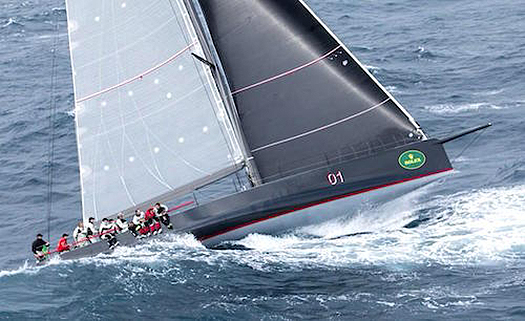
Ichi Ban finding her way through the waves on her way to Hobart. If that's not a spare tyre around her midriff, then what is it?
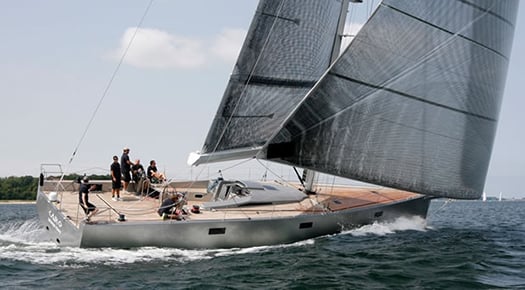
Despite being a "racer/cruiser", the Botin 65 Caro – navigated by Ian Moore – pipped Ichi Ban for third in class.
With the next Rolex Sydney-Hobart Race just over eleven months down the line, let's hope we're proven utterly wrong within the year on the Ichi Ban question. But the whole matter is pointed up by the fact that the boat which pipped in ahead of her in the IRC Div 0 placings in third place behind the two Cookson 50s was the Botin 65 Caro, with our own own Ian Moore navigating on this 65 footer which likes to emphasize her dual role as a racer-cruiser.
Now there really is food for thought. But in this first weekend of this wonderful new year of 2015, let's remember some of the events of December 1991 as recorded in excited detail in the Afloat magazine of Feb/March 1992.
On the cover is Meath-born John Storey's Sydney-based Farr 44 Atara, around which the Irish Southern Cross team of 1991 was built, as Harold Cudmore was aboard, and he brought out John Mulcahy from Kinsale and John Murphy from Crosshaven.
The small boat of the team was Tony Dunne's Davidson 36 Extension – the owner claimed Irishness through the Irish granny rule, but the matter was put beyond any doubt by Joe English being on board with Dan O'Grady and Conor O'Neill. And then for the third boat they'd Warren John's Davidson 40 Beyond Thunderdome, whose owner was happy to be Irish if they'd let him, and to put the matter beyond doubt his vessel was over-run by Howth men in the form of Gordon Maguire, Kieran Jameson, and Roger Cagney, with Dun Laoghaire's Mike O'Donnell allowed on board too, provided he behaved himself.

In the Southern Cross Series of 1991, the Davidson 40 Beyond Thunderdome was raced for Ireland by Gordon Maguire and Kieran Jameson. Thunderdome was top of the points table when she was knocked out with a dismasting in the final inshore race, and was unable to race to Hobart.
It was an accident-prone series, with Beyond Thunderdome dismasted in a tacking collision with one of the Australian boats with just three days to go to the start of the Hobart Race. There simply wasn't time to get a replacement mast, let alone tune it, but at the last minute the jury decided the Australian boat was at fault, and allowed Beyond Thunderdome average points not only for that race in which she'd been dismasted, but also for the Hobart Race which hadn't even yet been sailed.
In a final marvellous twist to the story, as Thunderdome couldn't race to Hobart, Gordon Maguire was drafted aboard Atara to add helming strength for the big one. Atara had only been a so-so performer until the big race. But Cudmore and Maguire – that really was the dream team. And it gave the dream result. Atara won the 1991 Sydney-Hobart race overall by a margin of one minute and 50 seconds. It was one of the closest results ever, but it was a close shave in the right direction for Ireland. The Irish party in Hobart to welcome 1992 was epic. And Gordon Maguire's sailing career was set on a stellar course.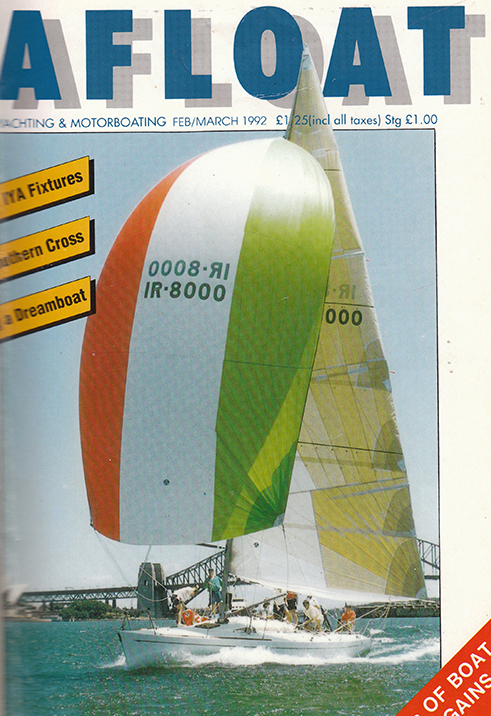
Our magazine edition of February/March 1992 cover-featured John Storey's Farr 44 Atara, overall winner of the 1991 Sydney-Hobart race with the dream team of Harold Cudmore and Gordon Maguire on board to give Ireland the win in the Southern Cross Series.
Irish Crews Among Small Boat Sailors Boosted By Sydney-Hobart Race Weather Forecast
#rshyr – In Sydney, forecasters have revealed that a southerly breeze will play in to the hands of smaller boats – including a number of Irish sailors – for Australia's 70th Rolex Sydney Hobart race that starts on St. Stephen's Day.
Irish crews competing in four days time include Sydney–based Gordon Maguire, orginally from Howth Yacht Club racing on the front–runner Carkeek 60, Ichi Ban. And as Afloat.ie previously reported, Barry Hurley of Cork Harbour and the Royal Irish Yacht Club leads a part Irish crew on the First 40 Breakthrough with Irish National Sailing School brothers Kenneth and Alexander Rumball and Dublin Bay sailor Catherine Halpin on board. Hurley, a Middle Sea Race Winner from October, gave an account of his Sydney–Hobart preparations here.
Locally based Irish sailor Keith Hegarty is racing his first Sydney-Hobart on Merlin, a Kaiko 51, owned and skippered by 81–year–old David Forbes, a legend in Australian sailing with an Olympic Gold Medal from Munich 1972.
There are estimated to be quite a number of Irish sailors competing in the race spread across the fleet.
Pam Lee, daughter of Greystones dinghy sailor Norman Lee, is racing on board Blacksheep, a Beneteau 45 rookie boat owned by Sharpie sailors Derek and Martin Sheppard from Wollongong. Lee is one of three girls on board and is sailing despite having her knee in plaster due to an unintended gybe during a night practice race in November when her leg got trapped by the mainsheet as she played the spinnaker sheet.
Read more on Irish participation in WM Nixon's blog here. Also more here from David O'Brien in last Friday's Irish Times Sailing column.
The early Christmas weather forecast gift to small yachts means the big glamour boats (including five maxis) may yet miss out on oan overall handicap win with smaller craft – roughly forty foot in length – favoured.
"We're really excited by this forecast," says Tom Barker, the navigator on the Ker 40 St George Midnight Rambler. "In terms of handicaps, the slow start means that is more time the big boats will have to take out of us.
The 117 yachts in the Rolex Sydney Hobart will face an early test this year, with the Bureau of Meteorology (BOM) forecasting a sharp 20 to 25 knot southerly change on Boxing Day afternoon not long after the start.
A southerly is expected to hold throughout the night at around 20 to 25 knots so it will be a long, wet first day for all crews.
Andrew Treloar from the BOM says winds will get lighter the further south the boats go, and the front runners should cross a high pressure ridge around Gabo Island giving them light westerlies across Bass Strait on Saturday.
Winds off the Tasmanian coast on Saturday night are also expected to be pretty light westerlies. They could be quite fluky.
"The midfield and tail end boats will get a better go from the wind," Treloar says. "They will tend to stay up around 10 to 15 knots right through as they cross Bass Strait and sail down the Tasmanian coast."
So this is a classic mid-sized to small boat forecast. A southerly on day one, stopping the super maxis from getting too far ahead, and a northerly after the glamour yachts are already tied up in Hobart.
For Irish Offshore Racing Sailors, 'Tis The Season To Be Sailing To Hobart
#rshyr – Tasmania is a medium-sized island in the Great Southern Ocean which is sheltered to the west only by South America. And as Tasmanians reckon skinny little New Zealand doesn't really provide a proper lee, they'll tell you their island is also sheltered to the east only by South America. So although it is at the same latitude in the south as Bordeaux in southern France is in the north, Tasmania's weather conditions – particularly the winds – can be much more extreme than they are in Bordeaux.
For sure, this lovely island can have some beautiful summer weather. But equally, it can serve up some very demanding sailing conditions. Thus the annual 628-mile Rolex Sydney-Hobart Race inevitably brings the fleet into increasingly hostile seas the further south they progress down much of the course. And the Bass Strait between Australia and Tasmania is a notoriously rough bit of water which has claimed lives in this event.
But then the twist in the tail is the final ten or so miles from the Iron Pot up the narrowing and increasingly flukey Derwent Estuary to the finish at the Hobart waterfront. This concluding crawl can test any sailor's sportsmanship as he or she sees a good position, hard earned over hours and days on a very rough sea, wafted away in calm spots and fickle zephyrs. Indeed, some hardened Hobart race veterans reckon the real contest finishes not even at the Iron Pot, but rather as you enter Storm Bay in the approaches to the Derwent Estuary, saying that it's just a lottery thereafter. But despite such criticisms, the race is one of sailing's great events. W M Nixon takes a look at this year's 70th staging of the classic, which starts in traditional style on Sydney Harbour in less than six days time.
If the annual Rolex Sydney-Hobart Race didn't exist, then world sailing would have to invent it. But happily, it's there already for our absorption and enjoyment. And in 2014 for its 70th staging, it's more relevant than ever in an era of instant global communication. When we remember that much more than half of humanity lives in the Northern Hemisphere and many of them are now in the depths of winter, the fact that there's this glorious and accessible sailing spectacle all ready to roll on screens worldwide, just as we're finally sated with Christmas and all its trappings, is a sanity-preserver for anyone interested in boats and sport.
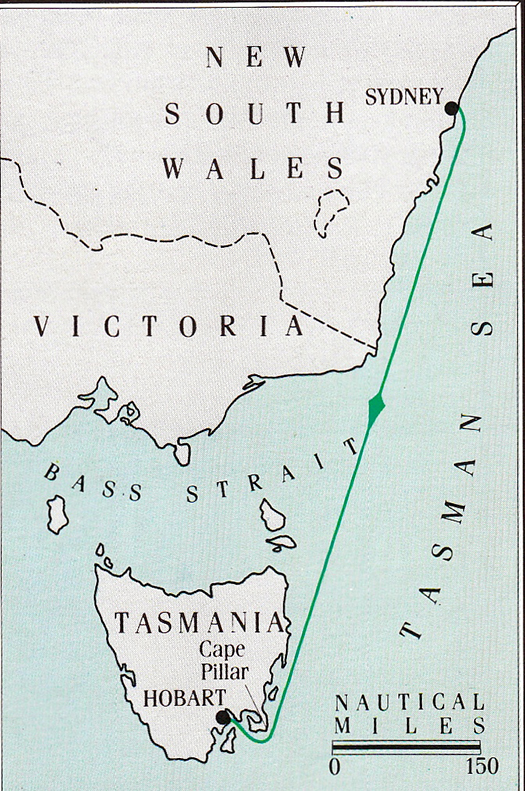
The great race's 628 mile course takes the competitors ever deeper towards the Southern Ocean with every mile sailed.
Of course there's Irish involvement in it at a specific level, with two boats in particular carrying our special interest. But at a more generous level, anyone who has the slightest interest in sailing cannot but be fired up by the wonder of an event in which some of the most advanced hundred footers in the world are swept up in a contest in which they will not only be in cut-throat competition with each other for line honours, but at the end, when all the calculations have been done, for dyed-in-the-wool offshore racing enthusiasts the real competition will be for the Tattersall's Cup, the hugely prestigious trophy for the overall handicap winner.
With 117 expected starters of all sizes from 33ft to 100ft, as the race gets under way each boat will have its own ideal set of conditions and circumstances to suit crew hopes. But as the contest continues, there'll be those who start to emerge in the leading group on handicap, and by the time they're in the final approaches, it is usually whittled down to about a dozen boats or even less which are in there with a shout for the Tattersall's.
But the line honours race for the Illingworth Cup – named in honour of the great British offshore racing skipper and innovator John Illingworth who first suggested the race in 1945 and won it too – now that's a different animal altogether. It's a real death or glory battle. And there's something specially entertaining and attractive about a no-holds-barred contest between boats you could like a lot, just at the time when the word is that the current flotilla of Volvo Round the World Racers may not be very likeable boats at all.
For we hear that the Volvo 65s are twitchy beasts, and not really fun to sail. To have a boat which turns round and looks at you is unfortunate. To have a boat which lies on its back and waves its legs in the air is unfortunate. But a boat that does both....? Oscar Wilde's Lady Bracknell said everything about such a situation.
So we'll return with relief to the crazy guys with the glorious big boats at the front of the fleet in the race to Hobart, for after the Volvo 65s, they're like a breath of fresh air. This is definitely not the territory of careful accountants and penny-pinching save-a-dime boatbuilding. We're looking at the stuff of legend. And the people's favourite has to be the veteran Wild Oats XI, marvellously campaigned by Mark Richards and his team of all the talents with the full support of the veteran owner Bob Oatley (86), whose wine brand of Wild Oats – one of many business interests – doesn't suffer any image problems at all when his boat of the same name wins yet again.
They talk of the Reichel Pugh designed super-slim Wild Oats XI as a "beloved old boat", but in truth she has been so continuously modified that you'd be hard put to say just what is original. The word is they've made her waterlines even narrower up forward – she used to be skinny, but now she's anorexic. As for last year's secret ingredient, the horizontal hydrofoil which, when deployed to lee, reportedly improved performance by up to 4% by making the boat better able to carry sail, for this year's race they tried making it even longer, such that it didn't entirely retract into the housing. But it seems that with a bit sticking out permanently on the weather side, it created more fuss than it was worth, so it has been shortened back to disappear entirely when not in use.
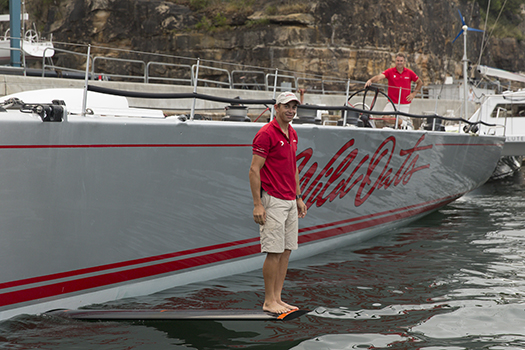
Wild Oats XI has so many bits and pieces sticking out of her hull that she has been compared to a Swiss Army Knife. This is skipper Mark Richards standing on the horizontal hydrofoil which, when deployed on the lee side, gives sufficient lift to significantly improve sail-carrying power. However, it has been shown that it has to be completely retractable into its housing when on the weather side, otherwise it causes unacceptable turbulence.
This conclusion on the downside of making the hydrofoil even longer emerged from some serious heavy weather sailing by Wild Oats off Sydney recently, when she was getting her final pre-Hobart race test and crew training. Heading back to port, with only about a quarter of the mainsail set in a very big wind, the silver arrow was making up to 33 knots. That will be food for thought for the four other hundred footers, the most challenging of which is of course Jim and Kristy Hinze Clark's new Comanche, just out of the wrappings, a hundred foot of total racer with Kenny Read as skipper.
The new girl on the block. American Jim Clark and his Australian wife Kristy Hinze Clark will debut their new hundred footer Comanche in the Rolex Sydney-Hobart 2014.
The same Kenny Read endeared himself to the Irish sailing community during the first Volvo visit to Galway five years ago, when he exited the dock somehow managing to look cool wearing a Paddy Hat that no-one else would be seen dead in. The boy is still busy, as he's worldwide president of North Sails, while his current main commitment afloat is to campaign the very extreme Comanche to the limit, with the Rolex-Sydney Hobart Race 2014 the first outing for real.

God be with the days.....five years ago, Kenny Read endeared himself to the people of Ireland by managing to look cool in this hat while exiting Galway Docks during the Volvo stopover. Photo: Failte Ireland/David Branigan
The hundred footers did have their first encounter a couple of weeks ago with the CYCA Solas Big Boat Challenge in Sydney Harbour, but racing boats this size in such relatively restricted water gives a somewhat skewed picture. Nevertheless the very experienced tacticians on Wild Oats still managed to finish first, as they did last year, but it was Comanche second quite a bit clear of Anthony Bell's Perpetual Loyal.
Once upon a time, Perpetual Loyal was very well known in Ireland, but that was in 2011 when she was George David's Rambler 100, and upside-down off West Cork. Until Comanche's appearance, Perpetual Loyal was reckoned the potentially fastest hundred footer of them all if she just could get enough wind in the right direction. But now the hundred footer field is wide open as a number of them have been undergoing major modifications of the kind you might expect to see on model yachts, but not on thirty metre hulls.

Can you see the join? The entire aft half of Rio 100 is entirely new, thanks to several months of major surgery in Auckland.
Thus the former Lahana, now American-registered, owned by Manouch Moshayedi and re-named Rio 100, simply had her entre aft half cut off, and replaced with a new wider stern section. Just like that. But you ain't heard nuthin' yet. The irrepressible Syd Fischer, shaping up to do his 50th Sydney-Hobart at the age of 87, decided that the hull of his hundred foot Ragamuffin needed some mods. A lot of mods. So he has just kept the deck and rig, but cut off the original hull, and replaced it with a new one from the same designer, Andy Dovell.
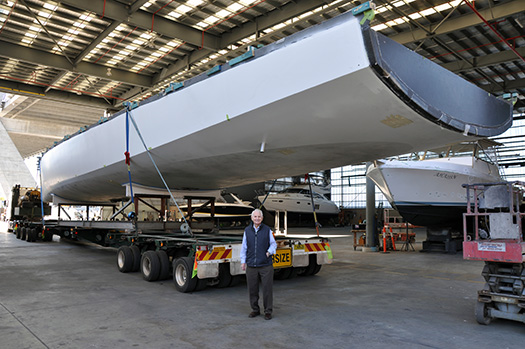
The incredible Syd Fischer, a sprightly 87-years-old, with the entirely new Andy Dovell-designed hull before it was fitted under the deck and rig of his previous hundred footer Ragamuffin.
So if next time you're on Sydney Harbour and a peculiar-looking hundred foot motorboat comes tootling past with a slightly lost air to her, you'll know why. She could swear that once upon a time she had a deep keel and a great big mast. But she's out and motoring about because there's no way Australians will let a redundant hundred foot hull go to waste. Meanwhile, the new raceboat hull has barely had time for testing, but we're assured all will be well, and the something old, something new Ragamuffin 100 will be there on the line raring to go against Wild Oats, Comanche, Perpetual Loyal and Rio 100 in the battle for line honours.
But as old Hobart hands will tell you, the real race is almost something else altogether. You'll have noticed that in mentioning the Solas Big Boat Challenge, we only talked of line honours. But it has an equally important IRC element as well, and two weeks ago the winner was Matt Allen's Carkeek 60 Ichi Ban, with Gordon Maguire the main man.

She may seem a plump girl by comparison with some other boats, but Matt Allen's Carkeek 60 Ichi Ban has been winning races, including the Solas Big Boat Challenge 2014. For the Rolex Sydney-Hobart 2014, skipper Gordon Maguire will be joined by ace Irish-born navigator Adrienne Cahalan.
And Ichi Ban's challenge in the Hobart race is even more Irish, as the Allen-Maguire team have linked up with Offaly-born Adrienne Cahalan to be navigator. One of Australia's top women sailors in almost any role, her navigational skills are legendary, and in the 2013 race she was navigating the 55ft Wedgetail to such good effect approaching the Tasmanian coast that they held the IRC lead, only for it all to come tumbling about their ears with a dismasting, which is hardly the navigator's fault.
So this time to Hobart, Ichi Ban really does have the dream team aboard. And though we still wonder if she's not just a little too plump in her waterlines forward to have that real cutting edge, the boat's results over the past year suggest that she has what it takes, and if the cards fall her way at all, she'll be clear to win.
Looking again at the top ten IRC boats in 2013, it's significant that apart from the freak presence of the hefty Swan 82 Nikata at 7th overall, only Ichi Ban at 8th overall was over 50ft long. The rest of the top ten were all 50ft or under, and the outstanding design was the evergreen Cookson 50, represented by both the overall winner Victoire (Darryl Hodgkinson), and the ninth placed Pretty Fly III (Colin Woods).
We in Ireland know well of the New Zealand-built Farr Cookson 50's brilliance through Chieftain (Ger O'Rourke), which later became Adrian Lee's Lee Overlay Partners, thus putting the Fastnet overall win of 2007 and the Caribbean 600 overall win of 2009 on the Cookson 50 winner-board before Victoire added the Sydney-Hobart win in 2013. It's some going for a design which first saw the light of day more than ten years ago.
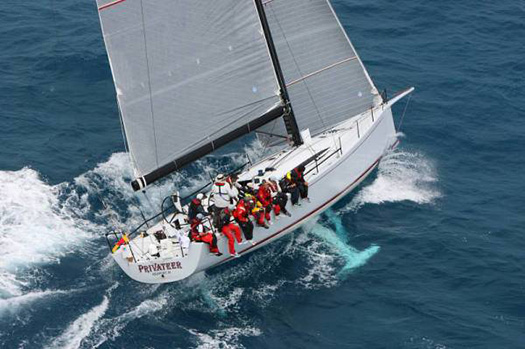
Privateer is one of the evergreen Cookson 50s, which have been consistently successful in the world's top offshore races for a decade
But as 2013's results show, doing well in the Sydney-Hobart has a huge element of horses for courses to it, and in 2010 the very new First 40 from Beneteau made a prodigious debut by taking first and second overall. They're still a very competitive boat, so not surprisingly there's five of them shaping up for the race to Hobart, and this is where the most direct Irish involvement comes, as Barry Hurley and his team have linked up with co-owner Mathew Vadas to put the beef in the crew of the First 40 Breakthrough. [Click to read Barry Hurley's preparations for this third successive Sydney–Hobart Race – Ed]
The same linkup saw Breakthrough take eighth in Class and 29th Overall in the 2013 race, but this time round Barry Hurley ships on board with the added experience of second overall and first in class in October's Middle Sea Race. With him to show that the boat is indeed sailing under the Dublin Bay Sailing Club colours are Catherine Halpin and Kenny and Alexander Rumball. And the word on the waterfront is that a shore support team not entirely unconnected with the Irish National Sailing School will be an enthusiastic presence in Sydney on December 26th. We look forward to hearing from them. Meanwhile, Happy Christmas everyone.
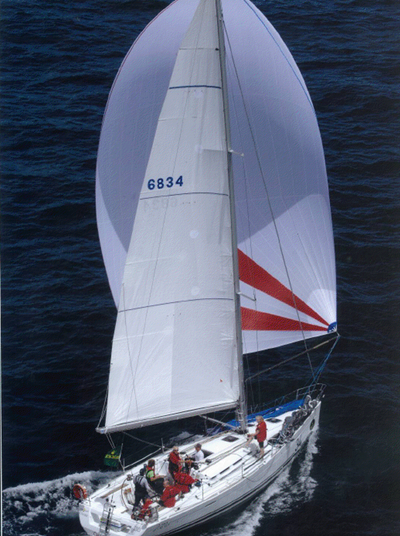
The First 40 Breakthrough will be racing under Dublin Bay Sailing Club colours in the Rolex Sydney-Hobart race 2014, starting December 26th
Irish Sailing Review 2014: A Year Of Hope, Regeneration & Success
#irishsailingreview – 2014 has been the year in which Irish sailing regained its international confidence afloat by re-capturing the Commodore's Cup. Having won it in 2010, the national economic collapse prevented any defence in 2012, but in July 2014 the stain and shame of 2012's non-appearance was emphatically wiped from memory with a convincing team victory led by Anthony O'Leary.
Ashore meanwhile, it had taken longer in some quarters for the economic realities to become fully evident and accepted. But for the Irish Sailing Association, a grassroots revolution within the national authority and sailing in general in 2014 resulted in a root-and-branch analysis of the workings of the Association, which had been heading towards financial disaster through a combination of over-staffing, grandiose schemes of expansion and empire-building, and an emphasis on activities and programmes which were remote from the needs of ordinary sailors throughout Ireland.
It took six months to turn round the course of the Association. But on November 5th 2014 the new ISA President, David Lovegrove, was able to announce a far-reaching re-structuring which is already resulting in a leaner and fitter body, better able to provide a realistic service for clubs and the huge diversity of recreational activity on Ireland's seas and lakes.
While all this high profile activity and action has been taking place at international and national level, those Irish sailors who had managed to keep up their sport through the financial downturn – albeit in often very reduced circumstances – continued to sail their boats with the attitude that, while the economic situation was disastrous, it mustn't be allowed to become serious, and in some ways the best course out of the recession was to sail through it. W M Nixon casts an eye over the year's main activities.
In the Irish sailing year, Christmas Day is New Year's Eve. Next morning, on December 26th – St Stephen's Day or Boxing Day or whatever you're having yourself – the annual 628-mile Sydney-Hobart Race starts. It may be on the other side of the world, and it may still be in the very last days of the old year. But Irish interest at home and in Irish-Australia is always high, and in the sailing community it's seen as the start of the new season.
December 26th 2013 was in line with this, as we'd ex-Pat superstar Gordon Maguire – a previous Hobart race overall winner – very much in contention with Matt Allen's totally new Carkeek 60 Ichi Ban, we also had Sean McCarter of Lough Swilly YC skippering Derry/Londonderry in the warmly-welcomed Clipper Fleet of 70-footers designed by Tony Castro (formerly of Crosshaven) which were taking in the Hobart race as part of their global circumnavigating race, and we'd Barry Hurley and Kenny Rumball on the First 40 Breakthrough knowing that in the 2010 Hobart race, the new design's race debut, First 40s had taken first and second overall.
In a rugged race in which the wind got up to gale force and more towards the end, it was a much-loved hundred footer, Bob Oatley's continually-modified Wild Oats XI, which stole all the headlines with line honours, a course record, and a class win. Irish hopes were best met by Sean McCarter, who logged a very clear win in the Clippers. As for Ichi Ban, while she was third in IRC Div 1 and 8th overall, it wasn't quite a stellar performance, reinforcing the views of those of us who think the boat may be just a little too plump by today's lean and hungry standards. And aboard Breakthrough, they'd 8th in class and 29th overall, a useful performance perhaps, but Barry Hurley will be back on December 26th 2014, boosted by his first in class and second overall in October's Middle Sea Race.
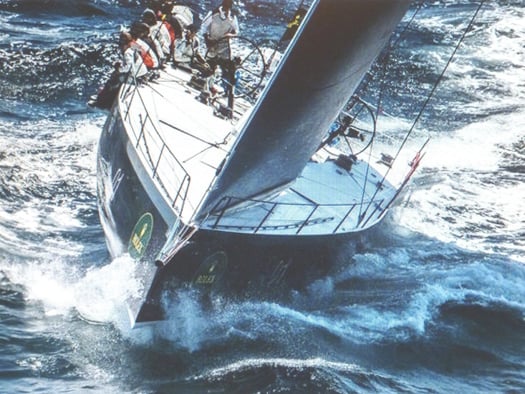
Matt Allen's Ichi Ban in the Rolex Sydney-Hobart Race of 2013, with Gordon Maguire as sailing master. To some observers, the very new Carkeek 60 seemed distinctly plump in her hull form forward compared to her closest competitors
In late January 2014, attention focused on the Quantum Key West Regatta in the Florida Keys, where Irish Olympic sailor Peter O'Leary of Cork was on the strength of New York art dealer Marc Glimcher's completely new and very potent looking Ker 40 Catapult. The boat did the business afloat in Florida, but further business was done ashore, as Anthony O'Leary himself was in Key West to see if he could sign up Catapult to be the secret ingredient in Ireland's Commodore's Cup team, for which at that stage the only certainty was his own older Ker 39 Antix. There seemed to be agreement, but in the volatile world of international trading and snap decisions in which top modern sailing operates, there can be sudden reversals of fortune, and O'Leary later admitted that until Catapult was actually unloaded from a ship in Europe, he hadn't been a hundred per cent certain she'd show.
Key West had further Irish interest in that veteran skipper Piet Vroon's Ker 46 Tonnere de Breskens – a former Round Ireland Race winner – was another star in the show, but much was to happen in Irish sailing before the Round Ireland 2014 got under way in Wicklow on June 28th.
With March slowly showing signs of Spring, university racing came centre stage, and it was University College Dublin which came through on top to qualify as Ireland's representatives in the Student Yachting Worlds in France in October, the team led by Philip Doran.
Another team was emerging as the Irish Cruiser Racing Association (ICRA) announced that our Commodore's Cup squad would be Anthony O'Leary's Ker 39 Antix, Marc Glimcher's Catapult, and the Grand Soleil 43 Quokka chartered by Michael Boyd and Niall Dowling, with Anthony O'Leary as team captain. He in turn would be supported by the shore management team, for a very intense week of racing, of Barry Rose and Fintan Cairns, with Mike Broughton in what would prove to be the particularly onerous task of Team Meteorologist.
As 2014 was exactly midway between two Olympiads, top level international dinghy sailing to Olympic standards might have been expected to be on the back burner. But Ireland's Olympians were very much on track on the international scene, and busy with their own programmes which culminated in the ISAF Worlds in Santander where Olympic places in Rio de Janeiro for 2016 were secured by James Espey in the Laser, Ryan Seaton & Matt McGovern in the 49er, and Annalise Murphy in the Women's Laser Radial. All were of course also seen in other boat types from time to time, with Annalise in particular bringing some glamour to the growing class of foiling Moths in Ireland.
Annalise on the foiling Moth
Other top international women sailors had descended on Ireland in early June with the ISAF Women's Match Race Worlds at Crosshaven. It's very much a specialist sailing interest, but aspiring Irish woman sailors attracted to this discipline found that this successful regatta provided some very useful networking contacts and future crewing possibilities, while the racing itself saw Sweden's Anna Kjellberg of the Royal Gothenburg YC become the new champion after defeating Camilla Ulrikkeholm of Denmark in the final.
In an entirely different area of sailing and life afloat, the traditional boat scene had come early to life with the Baltimore Wooden Boat Festival at the end of May. In the Irish climate after a particularly damp Spring, it reflected great credit on those involved that there was such a good turnout, ranging from the Shannon Gandelows from Limerick recently returned from their historic visit to Venice, through the many restored classic yachts of the region, also including the lovely Shannon cutter Sally O'Keeffe from Kilrush, and going on into the restored traditional mackerel and lobster yawls which make West Cork their home.

Shortly after their historic visit to Venice, the Shannon gandelows built by the Ilen School took part in the Baltimore Wooden Boat Festival at the end of May. The gandelow here, rowed by Liam O'Donghue, Anthony Kenny and Robert Samlle, is headed across Baltimore Harbour towards the gaff ketch Sile a Do.
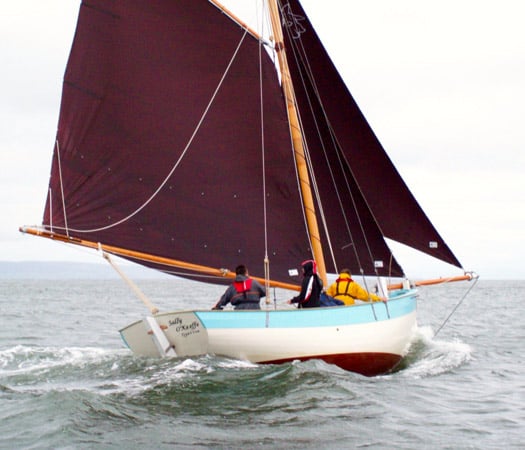
The pride of the Shannon Estuary - Sally O'Keeffe was built in a community effort in Querrin on the Loop Head peninsula.

The traditional lobster boat Saoirse Muireann (left, Cormac Levis) and the mackerel yawl An tiscaire (Uilliam O'Lorcain) are a familiar sight in the waters of West Cork. Photo: Brian Marten
They were to re-appear in even greater numbers at the Ballydehob Gathering of the Boats in early August, a month during which the classic Galway Hookers of the West Coast were at their busiest on their home Atlantic waters, but the East Coast also had its moments with the Riverfest in Dublin's Liffey in early June seeing traditional and classic craft in a lively mix.

Sails in the City – two of the 1898 Howth Seventeens racing in the heart of Dublin in the Liffey Riverfest. Photo: W M Nixon
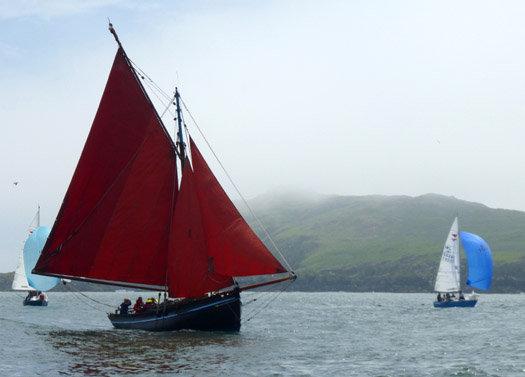
It could almost be Connemara, were it not for the Puppeteer 22s – the Galway Hooker Naomh Cronan in the new Classics & Traditional Division in Howth's annual Lambay Race, which was marking its 110th anniversary in 2014. Photo: W M Nixon
Indeed, so strong is the growing interest in classics and trads on the East Coast that to celebrate the centenary of the Lynch family's Howth 17 Echo (one of the newest of the class, the most senior ones were built in 1898) Howth YC provided a traditional Lambay Race course – simply up around Lambay and back to Howth Harbour – for the Seventeens and a new Classics Division, with the Howth 17s seeing the first two places taken by 1898 boats – Rita (John Curley & Marcus Lynch) and Aura (Ian Malcolm) – while Old Gaffers Association International president Sean Walsh won the classics with his Heard 28 Tir na nOg from the Clondalkin team's Galway Hooker Naomh Cronan. As for the overall prize among the large fleet of more modern boats sailing their more complex course, that was won by Colm Bermingham's Bite the Bullet.
The countdown to the Commodore's Cup had continued with inspirational performances by Anthony O'Leary in the Easter Challenge in the Solent, where he won his class with Antix, and then in June he did the same again with the British IRC Championship. Back home, ICRA held their Nationals with the Royal Irish YC in Dun Laoghaire in mid-June, and out of a fleet of a hundred plus boats it was the vintage Marcus Hutchinson/Rob Humphreys designed Quarter Tonner Quest (Jonathan Skerritt, RIYC) which was best overall scorer, a notably impressive performance also being put in by the Ker 36 Jump Juice (Denise Phelan) from Crosshaven.

The 27-year-old Quarter Tonner Quest (Jonathan Skerritt) was overall winner in the ICRA Nats at the RIYC in Dun Laoghaire. Photo: David O'Brien

Downhill battle at the ICRA Nats with the Mills 36 Raptor (ex-Aztec) in foreground, while beyond is Peter Dunlop of Pwllheli's J/109 Mojito against the XP33 Bon Exemple (Colin Byrne, RIYC). Photo: Davd O'Brien

The Ker 36 Jump Juice (Denise Phelan) dominated Class 0 at the ICRA Nats. Photo: David O'Brien
The end of June, and it was Round Ireland time. Thirty-six boats started from Wicklow, 33 finished in a race which was mostly on the slow side, with mid-size boats having their day. The winner was Richard Harris's Sydney 36 Tanit from Scotland by just six minutes from the home favourite, Liam Shanahan's J/109 Ruth from the NYC in Dun Laoghaire. The French defending champion, Laurent Gouy's Ker 39 Inis Mor which sails in Ireland under the burgee of Clifden Boat Club, placed third while Frank Doyle of Cork, second generation round Ireland aristocracy as son of Denis of Moonduster fame, was fourth with his A35 Endgame.
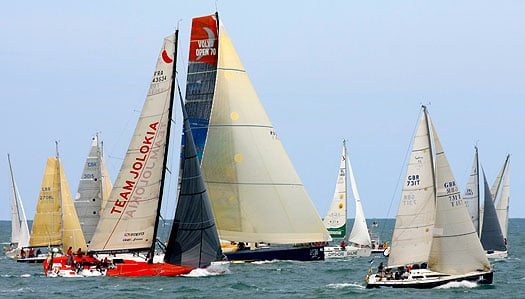
The start of the Round Ireland Race 2014 well illustrates the eclectic nature of the fleet. In right foreground is Richard Harris's Sydney 36 Tanit which was overall winner by just six minutes from the J/109 Ruth (Liam Shanahan), just beyond with the black jib, while the Volvo 70 Monster Project (David Ryan) comes thundering through the fleet at the beginning of a performance whch would see her take line honours win and thd class win in the CK Div.. Photo: Kevin Tracey
The same weekend as the Round Ireland race started, Lough Foyle sent the Clipper Fleet on their way after a week's festivities in Derry/Londonderry, made even more festive by the fact that Sean McCarter and his crew with the home town's boat had crowned their win in the Sydney-Hobart race with victory in the Transatlantic leg to Derry.
Clipper fleet in Derry
Crosshaven fairly leaped to life with Cork Week in July, and after several hitches in various boat-shipping plans, it was notable as the first time the Irish Commodore's Cup Team 2014 were seen together, and mighty impressive they looked too, with Quokka proving best on the Cork Week leaderboard.
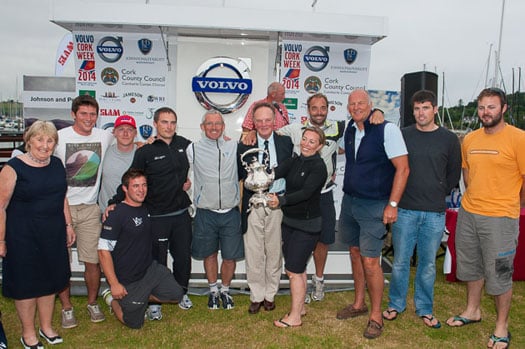
Michael Boyd (centre behind cup) and his Quokka crew, a member of Ireland's Commodore's Cup team, were overall winners of Cork week 2014. Photo: Bob Bateman
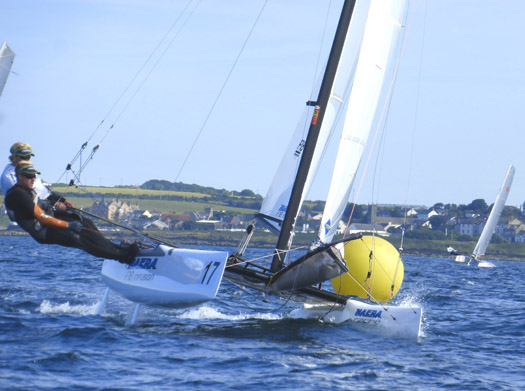
In the F18 Worlds at Ballyholme, Dutch skipper Gunnar Larssen (crewed by Ferdinand van West) is seen here putting in the smooth performance which saw him winning the worlds at his thirteenth attempt. Photo: W M Nixon
While all this excitement in racing boats with lids was building on the south coast in July, up north on Belfast Lough at Ballyholme the F18 Worlds were held for one of global sailing's most popular catamaran classes. Though the entry of 56 boats didn't match the 150-plus entries they get when the class has its worlds in its Mediterranean heartlands, the sailing was good and a popular winner emerged in longtime F18 sailor Gunnar Larsen, who is Dutch despite his Scandinavian name.
Dinghy attention was also very closely focused on Dublin Bay, with an enormous fleet of Optimists at the Europeans hosted by Royal St George YC from 12th to 20th July, and Dun Laoghaire really showing what it can do in being a major international regatta centre. France's Enzo Balanger was tops from Sweden's Kasper Nordenram, while best of the Irish in the Gold Division was Royal Cork's James McCann in tenth – not surprisingly, he was to go on to win the Nationals at his home club in August.

Nations from across Europe and beyond were at the Optimist Euros at Dun Laoghaire

Finn Lynch racing at Douarnenez in France where be became the new U19 Laser Standard world championPhoto: Trevor Millar/Sail Coach
On the broader international scene, former Opty stars Finn Lynch (National YC) and Seafra Guifoyle (Royal Cork) were to turn in outstanding results during 2014, with Guilfoyle firmly in the frame through the ISAF Youth Worlds in the Laser, eventually coming home from Tavira in Portugal with the Silver, while Finn Lynch was on top form to clinch the Gold in the Under 19 Laser Standard Worlds at Douarnenez in Brittany.
Back aboard the boats with lids, late July had brought the Commodore's Cup in the Solent, and if anyone out there doesn't know who won, we'd like to hear from them, as the state of total seclusion which this implies is surely something which could be packaged and marketed to our hyper-informed and over-crowded world. The comprehensive Irish victory just seems better and better with the passage of time, and for Anthony O'Leary it was the highlight of a fantastic season which in September was to see him win the Helmsman's Championship of Ireland (admittedly by just a whisker) in J/80s in Howth to set up a national double for Royal Cork, as young Harry Durcan of Crosshaven was winner of the Junior Helmsmans. O'Leary meanwhile went on to win the 1720 Nationals in Baltimore later that month, and then in November his beloved Antix was named RORC Yacht of the Year.

Antix in the Commodore's Cup, hanging in well coming to the weather mark to stay ahead of the newer Ker 40 Cutting Edge. Photo: Rick Tomlinson)
Even as Antix and her team mates were racing on towards glory in the Solent, in Clew Bay the West of Ireland Offshore Racing Association (WIORA) were staging their annual championship at hospitable Mayo SC, and it saw a good spread of results, with the overall winner being Galway's Liam Burke with his Corby 25 Tribal, while the runner-up was the McGibneys' Dehler Optimum 101 Dis-a-Ray, which sails under the Foynes YC burgee, but her home port is Tarbert further west along the Shannon Estuary.
August was busy with events for enjoyment. Eighty boats raced in Calves Week in West Cork, which has now been compressed to a four day regatta which means, as one sage family man observed, that you can take a house in Schull for a week's holiday, and then just as the wife and kids are getting fed up with having the ould fella always about the place, doesn't he absolutely have to go off and spend the last four days of the holiday sailing with his mates? That one of the top boats was Colman Garvey's True Penance maybe says it all.

Calves Week 2014 entries were up 25% in 2014. Photo: Bob Bateman

The GP14 Worlds at East Down YC in Strangford Lough launched a hundred boats every day in smooth style. Photo: W M Nixon
The biggest dinghy event of all (other than the Laser Nationals, which as ever are in a league of their own) was the GP 14 Worlds in mid-August at East Down YC in Strangford Lough, which had its excitement in a sudden storm on the Monday, but it all turned out okay. Boats involved were just over the hundred mark, the best boats were built in Northern Ireland by Alistair Duffin, and winners were English crew of Ian Dobson and Andy Tunnicliffe from Burwain, while top Irish were John and Donal McGuinness of Moville in Donegal, they were sixth.
At the other end of the intensity scale, down in Howth they had their first cruiser-racer two-hander for the Aqua Restaurant Challenge. Despite very restrained pre-publicity, it attracted 34 boats for a race round Lambay and the Kish. Stephen O'Flaherty's elegant Spirit 54 Soufriere, fresh from a win in the Panerai Classics in Cowes and co-sailed by David Cagney, took line honours and almost won, but the vintage Humphreys Half Tonner Harmony (Peter Freyne and Jonny Swann) just pipped them at the end.
Sailed in summery weather, the new Howth two-handed was about as different as possible from another two-handed experience in August, that of Liam Coyne (NYC) and Brin Flahive (Wicklow) in the 1800 mile RORC Seven Star Round Britain and Ireland. They didn't have to be two-handed, there were fully crew boats involved including the 70ft–trimaran Musandam in which Ireland's Damian Foxall played a leading role in taking line honours in record time, but aboard the First 36.7 Lula Belle the Irish duo just toughed it out despite sailing the last 500 miles with virtually nothing functional, they simply decided to see it through, and to their amazement found they'd won Classes V & VI.
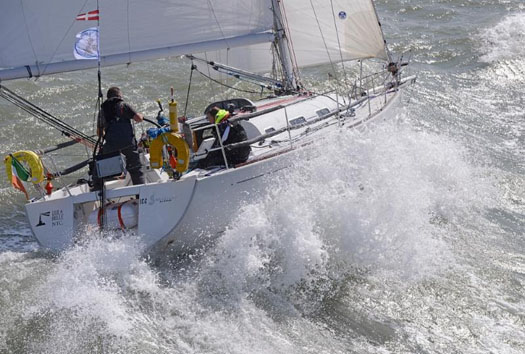
Lula Belle on her way out of the Solent with 1800 miles to race. Photo: Rick Tomlinson
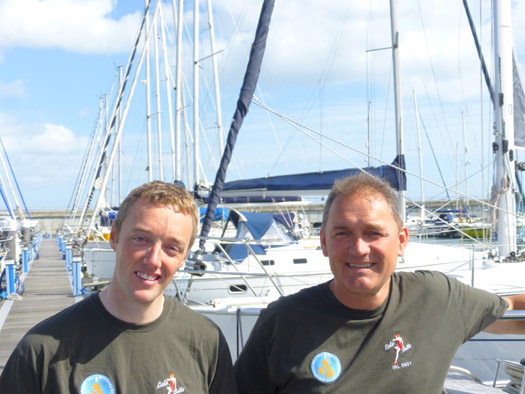
Brian Flahive & Liam Coyne back in Dun Laoghaire on the morning of their return from the finish of the Round Britain & Ireland Race. Photo: W M Nixon
As for the Laser Nats, they were at the end of August and another Ballyholme event, with Johnny Durcan of Royal Cork winning from Rory Fekkes of the home club, while the radials saw Annalise Murphy keep her hand in with a win from Cork's Cian Byrne.
After some rugged August weather, particularly on Ireland's East Coast, September was utterly blissful and it sweetly rounded out Dublin Bay Sailing Club's 130th season, the birthday being marked by a fairly epic dinner in the National YC. September also saw the conclusion of the slowly but steadily reviving Irish Sea Offshore Racing programme, with the end-of-season race from Pwllheli to Dun Laoghaire seeing Liam Shanahan's J/109 Ruth confirmed as the overall winner of the series. Among locally campaigned dinghies, meanwhile, Dun Laoghaire's keen Fireball Class kept its annual programme in lively shape, and the season drew a close with Barry McCartin and Conor Kinsella winning overall from Noel Butler and Stephen Oram.

ISORA Champion Ruth skippered by Liam Shanahan jnr from the National Yacht Club
Across country in Limerick, the CityOne dinghies and the traditional Shannon gandelows created in projects of the Ilen Boatbuilding School made their debut in the city centre on one of the last days of the Indian summer, and then they were put on display in a Naumachia in St Mary's Cathedral which was officially opened by Michael Noonan TD, and later formally visited by President Higgins.
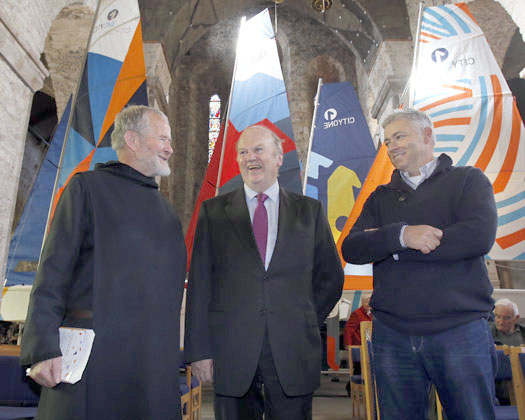
The hopeful new spirit of Irish sailing in 2014 was evident in St Mary's Cathedral in Limerick, when the CityOne dinghies built by volunteers in an inner city revitalisation project went on display in a Naumachia in the Cathedral on September 26th, after their first regatta on the Shannon in the heart of Ireland's City of Culture 2014. With the boats in the cathedral were (left) Brother Anthony Keane of Glenstal Abbey (Director, the Ilen School), Limerick's senior TD and Ireland's Minister for Finance Michael Noonan, and Gary MacMahon (right) Director of the Ilen School & Network for Wooden Boatbuilding. Photo: Press22
And then more vigorous winds returned in October, with the Freshwater Keelboat event on Lough Derg – originally just an exclusive Dragon thing – finding itself swamped with sixty and more boats from five classes and increasingly rugged conditions, such that only the Dragons and Squibs managed to get in any meaningful racing, with Neil Hegarty (RStGYC) winning the Dragons while James Matthews and Rob Jacob of Kinsale topped the Squibs.

Dragons in Autumn action on Lough Derg – Neil Hegarty (right) was overall winner from runner-up Richard Goodbody (left) Photo: Gareth Craig
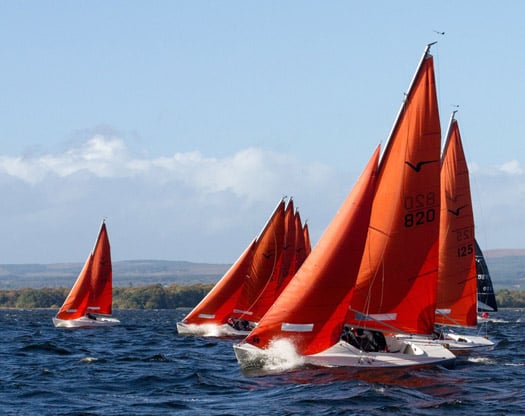
Squibs on Lough Derg – it may look like perfect sailing, but the top came off the weather very soon afterwads. Photo: Gareth Craig
The Student Yachting Worlds in La Rochelle in October had some hiccups in UCD's campaign for Ireland, but while they very narrowly missed the podium in a truly international event, they stayed put at fourth overall. And round in the Mediterranean, a record fleet for the Rolex Middle Sea Race from Malta saw entries soar through the 120 mark for the first time, and the 606 mile race had its first half in light breezes, but the second half was in pure Mistral, with people talking of "winds easing to 44 knots....." A Maltese-owned J/122 won, but second overall and first in her class was the Xp44 XpAct (Josef Schultheis) with a strong Irish emphasis in her crew including Barry Hurley, Andy Boyle, Kenny Rumball and Phillip Connor.
Soon afterwards, the Volvo World Race got under way with first stage from the Med to Cape Town, and Ireland's Justin Slattery on the winning boat on Leg 1. Back home, Autumn leagues had seen renewed enthusiasm as though people had suddenly re-discovered their sport, and the great sailing year of 2014 drew towards its close with the Lasers in Howth starting their 40th winter of annual frostbite racing. This means that HYC have now had a continuous sailing programme since April 1974, while across in Dun Laoghaire the DMYC Frostbite Series must be the most senior of all winter events. Winter Leagues attract more aficionados, with the popularity of the Dublin Bay Turkey Shoot in particular providing a forceful reminder that Dun Laoghaire is the principal sea access for a notably affluent and very large population in South Dublin. With the Turkey on its way, soon it's Christmas. And then the new Irish sailing season will begin on the blue waters of Sydney Harbour.
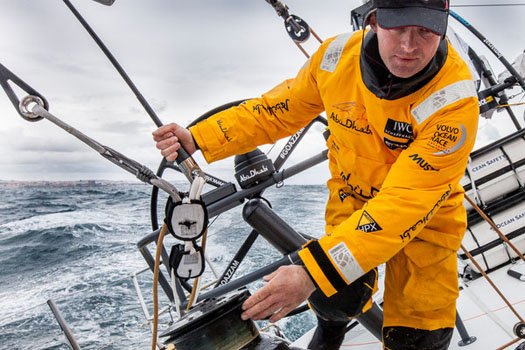
Justin Slattery on Volvo World Race 2014. Photo: Volvo Ocean Race
Mini Maxi Yacht Loki with Irish Connections is Up for Sale
#boatsforsale– The mini Maxi Loki in which Dublin Sailor Gordon Maguire won the 2011 Rolex Sydney-Hobart Race, a high point in his career as a leading international professional sailor based in Australia, is now for sale.
Loki is a high performance racing yacht that has been professionally maintained and has a proven offshore and inshore track record. The advert for Loki is attached below.
The offshore pedigree of this yacht is second to none and offers a turn-key solution that will allow her new owner to compete to a high level in
both inshore and offshore regattas anywhere in the world.
The recent significant drop in the Australian Dollar makes Loki even more attractive especially when yacht designers Reichel Pugh say they have a motivated seller and all offers are to be considered.
No expense was spared in the build and upkeep of LOKI. Certainly one can build a new Mini Maxi design at a cost of three times LOKI's sale price and still not be guaranteed to win the next Sydney-Hobart, Bermuda Race or Fastnet, something that LOKI is well capable of, say Reichel Pugh.
Outfitted with a superb rig, sails and hardware, all LOKI needs is a new owner and team who want to Win Blue Water Classics or Inshore Races. Round Ireland anyone?
Sydney–Hobart Race: Breakthrough Under Radar is a Beau Geste
#rshyr – It is developing into one of the most complex Rolex Sydney-Hobart Races sailed in many a long day. And as it's in the upside-down Southern Hemisphere, weatherwise everything moves in different ways. W M Nixon isn't sure he has a clue what's going on, but he happily throws in his pennyworth to add to the confusion.
One surefire way to get publicity is to keep things secret, just releasing tasty bits of info at the last minute. With the Rolex Sydney-Hobart Race providing a focal point of sailing attention at a time when most of the world is being distracted by minor matters such as celebrating Christmas, or simply getting through midwinter storms, the opportunities to make a show-stopping impact are magnified.
A dearth of maritime stories at home makes the saltheads leap at anything of cheerful sailing interest. For there are only so many ways that you can report that ferries aren't sailing at all, or are delayed. If we never hear the phrase "operational reasons" again, it will be too soon. And sad and all as we are about the huge whale in Achill, we were too far away to do anything about it. But give us something like the sudden appearance of Karl Kwok's startling new 80ft Beau Geste in Sydney just a couple of days before the race to Hobart begins, or the news on Christmas Day that a First 40 formerly thought of as just another Australian boat is actually an Irish entry in disguise and slipped in under the radar, then we come to life.
Naturally there'd been plenty of stories circulating about the new Kwok boat. However, as the other serious biggies in the Hobart fleet began to strut their stuff around Sydney harbour through December, inevitably they hovered up the attention. But then on Sunday, out of the blue, Beau Geste sailed into Sydney after a crisp and very satisfying four day test passage across from New Zealand, which is cooking with gas
.
Anybody mind if we come in? The brand new 80ft Beau Geste arrives in Sydney on December 22nd after her speedy maiden voyage from New Zealand. Photo: Rolex/Carlo Borlenghi
You can understand the reluctance of skipper Gavin Brady and the rest of Karl Kwok's team to seek the limelight. The previous much-admired Farr-designed 80ft Beau Geste, winner of many trophies, had suddenly as near as dammit broken in two off Norfolk Island during the 2012 Auckland-Noumea Race. The good folk of Norfolk Island did their best to help out, as did ships and fishing boats in the neighbourhood, but to this day nobody is too sure how the big boat stayed afloat long enough to be got to port.
There they were, all the gear intact, but the hull a write-off. They say that when you're unhorsed you should get back in the saddle immediately if the horse isn't injured. But this was one terminally injured nag. So they did the next best thing. They went to designer Mareclino Botin, he who created the Volvo 70 Camper which was the most radically different of the generally similar Volvo flotilla last time round, and ordered up a new canting keel 80 footer with debut planned for the 2013 Sydney-Hobart Race.
Built by Cookson in Auckland with beefed up engineering by comparison with the previous boat, but carrying some of her gear, the new boat is of interest every which way, as Botin used to be in partnership with Shaun Carkeek, who has designed the much-fancied 60-footer Ichi Ban for Matt Allen. And you can see (or maybe imagine) certain distant style resemblances between the two boats. But as the new Kwok boat follows Botin's enthusiasm for having the mast well aft (it was so far aft in Camper it was astern of the canting keel), it wouldn't be an exaggeration to describe Beau Geste as a one-masted schooner, though no more so than Volvo 70s like Giacomo.
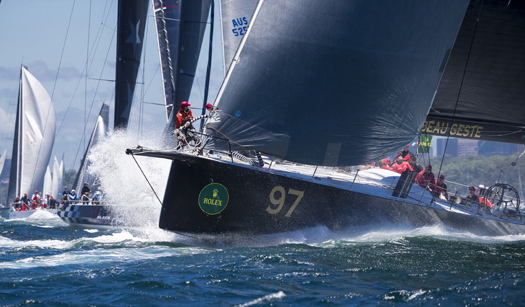
Baptism of fire. The Sydney-Hobart 2013 is Beau Geste's first race – she'd barely been afloat for a month when it started on Thursday. Photo: Rolex/Daniel Forster
Nevertheless, the first time this slightly offbeat boat had a crack at the opposition was in that initial crazy eight minute drag race down Sydney harbour at the start of the race to Hobart on Thursday. Of which more anon. But meanwhile, what's this about an Irish entry disguised as a bog standard Australian one?
Well, they sprang it on us all with perfect timing on Christmas morning. There in the entry list is Breakthrough, a First 40, a boat type always of high interest - when the design was new, back in 2010, two of them took first and second overall in the Rolex Sydney-Hobart Race.
It was a marketing dream for Beneteau, for each race to Hobart will always produce a particular set of conditions which will suit one boat type to a T. In 2010, it was the very new First 40 which hit the spot, coming forward to step into the very big shoes so capably filled for years by the marvellous First 40.7.
They may have got everything right, but circumstances conspired against the new First 40 being a runaway marketing success. Primarily, it was the global recession taking hold big time, particularly in Europe. But then too, there was still plenty of life in the First 40.7, with thriving class associations, and one design racing in events like Cowes Week.
Whatever, we've only seen two First 40s in Irish ownership since the design appeared, one in Baltimore and used for cruising, the other based in the Algarve. But now the good news is that Barry Hurley is actually the skipper of Breakthrough on the race to Hobart. It must be true, as you read it here on Afloat.ie on Christmas morning while talking to that fat white-bearded man in the red suit.....But enough. Even if the official CYCA listing suggests Mathew Vadas is the skipper, man in charge is Barry Hurley, already with two Hobart races notched, and with him he has brought Kenny Rumball, Keith Kiernan and Catherine Halpin, all of the Royal Irish YC, to sail in partnership with the Vadas team, and hoping to repeat that Hurley touch which brought a class win in the Middle Sea Race back in October.
As for the big boat start – well, it was eight minutes like we'd never seen before. Morning clouds had cleared to leave Sydney Harbour at its sparkling best in a brisk sou'easter, reaching start to the first mark, and the biggies went off first at max revs with Wild Oats and Perpetual LOYAL neck and neck for the lead, with Anthony Bell's Perpetual in the weather gauge.

The power of Perpetual LOYAL's hull is plain to see – but that power with its extensive wetted area comes at the expense of light weather performance. Photo: Rolex/Daniel Forster
But the "old" Wild Oats never ceases to surprise, or maybe Mark Richards and his crew know her so well that they can hit top performance while others are still winding up to it. They simply held Perpetual up above the line to the first mark until they were able to peel away for a short run to the turn which left enough of a gap between them and the big black boat to allow Beau Geste to nip in between in second place.
The abiding memory of that eight minute sprint was the way the different boats had sudden bursts of acceleration. You'd to keep reminding yourself that the smallest craft in this flotilla were 70ft Volvos, for all were having speed bursts like dinghies on the plane.
So that was interesting, but then as they started the beat south in open water, it became clear that Wild Oats with a reef in the main was holding on very nicely ahead of the supposedly more powerful Perpetual, while the smaller Beau Geste was sagging to lee. But then, schooners never could point high, whereas Wild Oats' pointing ability in a lumpy sea was a wonder to behold.
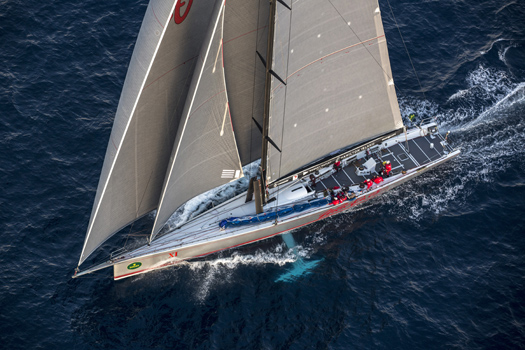
The skinny one....thanks to her slim hull, in the light airs on Day 2 Wild Oats was able to re-take the lead from Perpetual LOYAL. Photo: Rolex/Carlo Borlenghi
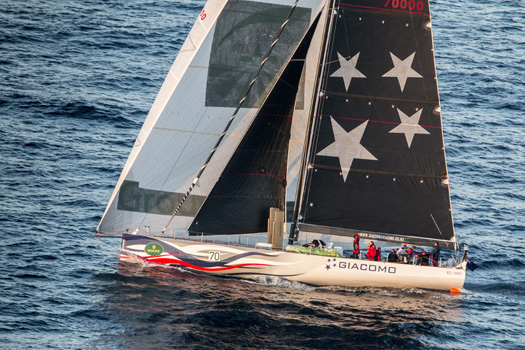
The Volvo 70s may have been developed for big winds in open water, but the former Groupama, now racing for New Zealand as Giacomo, has shown she can hang in when the breezes are light. Photo: Rolex/Carlo Borlenghi
Through the first night, the wind went light, and things were further turned on their head by ace navigator Stan Honey taking Perpetual LOYAL well to the east, which did her a lot of good. By morning they'd worked out an eleven mile lead on Wild Oats, but through the second day of light winds, Wild Oats ground down the big black boat, and as they crossed Bass Strait yesterday evening it was the old dog for the long road, Wild Oats still in the lead and hoping to have the advantage of an afternoon/evening arrival up the Derwent to Hobart before tonight's freshening northerly is replaced by southwest to west winds which could reach gale force, stacking the odds against the little fellows.

By comparison with some of the boat shapes racing to Hobart, Matt Allen's 60ft Ichi Ban with Gordon Maguire on the helm looks almost traditional. Photo: Rolex/Carlo Borlenghi
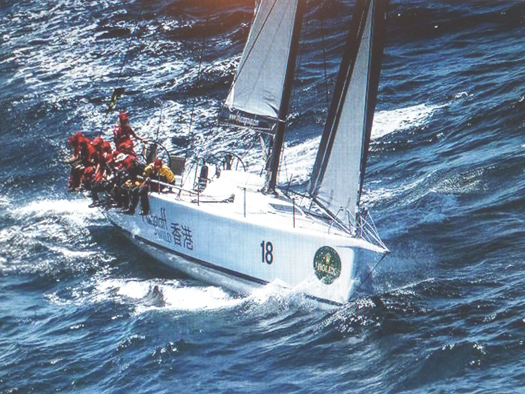
With the renowned Adrienne Cahalan as navigator, the 55ft Wedgetail is in with a shout. Photo: Rolex/Carlo Borlenghi
But meanwhile the top Irish hope, Gordon Maguire with Matt Allen's 60ft Ichi Ban , has been hanging in very nicely and things could fall sweetly their way. That said, while the 60ft Ichi Ban has been staying on the tails of the big boats ahead, not so far astern is the next size group with the lead held by Bill Wild's Reichel Pugh 55 Wedgetail. Formerly Yendys, this is one of Australia's proven all rounders. And for this first race to Hobart under the Wild command, Wedgetail's navigator is Adrienne Cahalan, who is renowned for seeing skippers on to the Hobart podium. But then, she was born in Offaly, and that makes all things possible.
Gordon Maguire Lifts Sydney-Hobart Trophy
#SYDNEYHOBART – Dublin Sailor Gordon Maguire won the Rolex Sydney-Hobart Race, a high point in his career as a leading international professional sailor based in Australia writes W M Nixon in the Irish Independent.
Twenty years ago, the young Howth helmsman was one of the key players in the Irish team which won the Southern Cross Trophy, the international offshore series which culminated in the Hobart Race.
For someone with Maguire's remarkable talents, Australia offered the perfect arena and base, and he increasingly focused on the active scene down under. But he also continues to sail worldwide, his most recent high profile appearance in Ireland being three years ago when he was lead helm on Mike Slade's 100ft Leopard establishing the course record in the Round Ireland Race.
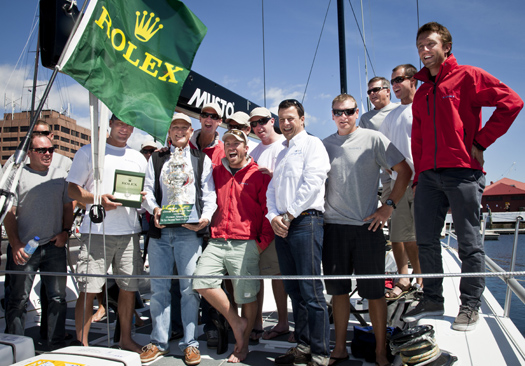
The winning Loki crew included Howth's Gordon Maguire. Photo: Daniel Forster/Rolex
Since then, his career path has been as sailing master with Stephen Ainsworth's Australian team. Ainsworth acquired some note in Europe back in 2007 when his mini-maxi Loki, powering along in the stormiest Middle Sea Race yet experienced, broke the rudder and became a total loss on the northwest coast of Sicily. That iron shore would rank high on any world listing of least desirable places to be shipwrecked, and some advanced yacht racing equipment subsequently turned up in unlikely mountain sales.
But at least no-one was hurt. And a new Loki, a 63ft Reichel Pugh design, was already on the drawing board. To get the best from the new boat, Ainsworth and his ace navigator Michael Bellingham signed Gordon Maguire (48) onto what became a dream team. Since 2008, Loki has won just about everything of significance in the Australian eastern seaboard offshore racing scene except the annual thrash to Hobart, which Ainsworth has been trying to win for more than a dozen years.

The winning mini-Maxi Loki. Photo: Daniel Forster/Rolex
The 628-mile classic – staged annually since 1945 – can be a tricky one. You go like the hammers of hell on rough ocean for upwards of 550 miles, and then the final approach to Hobart up the narrowing 60-mile ria of the Derwent River sees the winds all over the place, and often non-existent at night.
The new Loki (named for the Norse god of mischief and trickery) invariably finished among the leaders, but then saw her corrected time win for the Tattersall's Cup – Australia's premier offshore trophy – being snatched away by some smaller boat which came creaming up the Derwent on the afternoon breeze.
But Ainsworth and Maguire have been very close to the cup for the last two years, and this year they struck gold. It was the turn of the smaller boats to be becalmed in the small hours. After hours of the clock ticking painfully slow, Loki was declared winner of the Tattersall's Cup. The biggest box of all had been firmly ticked in gold.




























